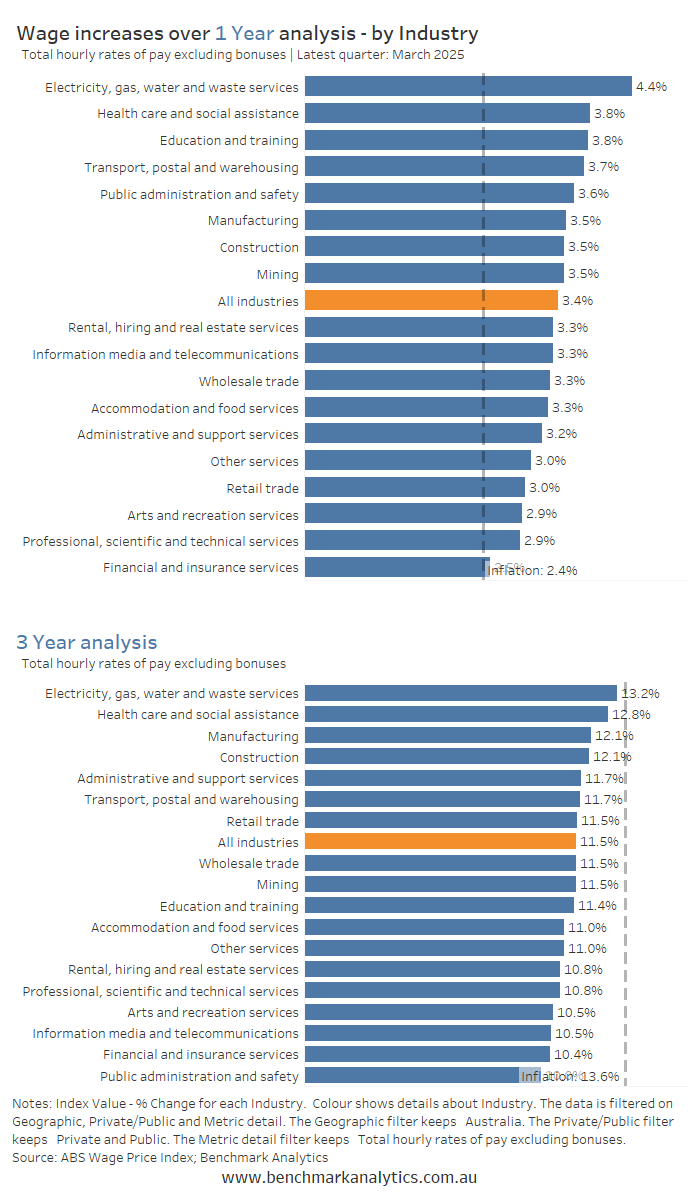Lucky escape - Albanese avoided election pain on real wages
Data Alert | Wage Price Index for March Qtr 2025
The ABS has released the latest Wage Price Index. This is a highly anticipated release because it provides the benchmark against which governments are judged on whether they are delivering real wage increases.
Increasing real wages was Labor’s primary promise during the May 2022 election campaign, so a key question in the most recent election has been whether the Albanese Government has delivered on that commitment. Today’s data provides evidence to assess that claim. (Real wages are defined as the percentage change in wages minus the percentage change in inflation.)
Anthony Albanese put it this way in his 2022 Budget Reply:
“The relentless pressure of flat wages and rising prices won’t stop because of a short-term, pre-election promise. The truth is, if you want real, permanent, meaningful help with the cost of living, you need a plan to get wages growing again. And you need a Labor Government to do it.”
The positive news for Labor is that over the past year, real wages have grown by an average of 1.0% across the economy. During this time, nominal wages rose by 3.4%, while inflation increased by 2.4%. On a one-year basis, the Labor Government is beginning to deliver on its promise.
However, over the past three years, Australian workers have gone backwards in real terms. Nominal wages have increased by 11.5%, but inflation has risen by 13.6%. Albanese largely avoided scrutiny on this fact in the last election. Lucky escape.
These statistics are summarised in the two charts below. The first shows inflation (dotted line) and real wages over the past year. The second presents the same analysis over a three-year period. Both charts also show wage growth by industry. Workers in the utilities sector (electricity, gas, water and waste) have enjoyed some of the strongest wage growth over both timeframes.

Technical note on construction of the Wage Price Index, excerpt from the ABS website:
The methodology used to construct the WPIs is similar to that used for other price indexes such as the Consumer Price Index. In the WPI, index numbers are compiled using information collected from a representative sample of employee jobs within a sample of employing organisations.
Individual indexes are compiled for various combinations of state/territory, sector (private/public) and industry division. Industry is classified according to the Australian and New Zealand Standard Industrial Classification (ANZSIC) 2006 (cat. no. 1292.0). For more detailed information on the methodology used in the construction of the WPI, refer to Wage Price Index: Concepts, Sources and Methods (cat. no. 6351.0.55.001).
Current published indexes
Four WPIs are constructed and published quarterly. These indexes were first compiled for the September quarter 1997, and cover:
- ordinary time hourly rates of pay excluding bonuses index
- ordinary time hourly rates of pay including bonuses index
- total hourly rates of pay excluding bonuses index
- total hourly rates of pay including bonuses index.
In these indexes the term 'bonuses' refers to bonuses and commissions.
Design of the indexes
The WPIs measure changes over time in the price of wages and salaries unaffected by changes in the quality or quantity of work performed. A range of procedures have been developed to identify and measure quality and quantity changes and ensure that only pure price changes are reflected in the indexes.
Price-determining characteristics of the jobs are fixed to ensure that changes in these characteristics do not contribute toward index movements. The following are examples of changes in price-determining characteristics which are not reflected in index movements:
- changes in the nature of work performed (e.g. different tasks or responsibilities)
- changes in the quantity of work performed (e.g. the number of hours worked)
- changes in the characteristics of the job occupant (e.g. age, apprenticeship year, successful completion of training or a qualification, grade or level, experience, length of service, etc.) changes in the location where the work is performed.
Changes in the price of wages and salaries resulting from changes in the composition of the labour market are also excluded from index movements. To achieve this, a longitudinal survey methodology is used to measure a similar sample of jobs over time. Once a business is selected in the sample, it will be expected to provide data for a sample of jobs for a minimum of five years.
Wage price indexes
The ordinary time hourly rates of pay indexes that exclude bonuses measure quarterly changes in ordinary time hourly wage and salary rates. Changes in rates of pay reflected in these indexes (i.e. pure price changes) arise from a range of sources including award variations, enterprise and workplace agreements, minimum wage setting, individual contracts and informal arrangements.